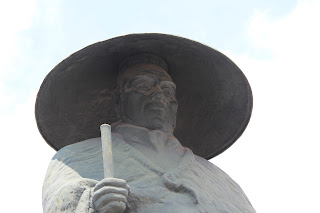I got there and it was sweltering and there is very little shade, but I toughed it through and ventured in through the gate. This monk was there standing as people entered.
The reason I chose to spend my last day going to the Temple rather than going shopping or spending it in the metropolitan area of Osaka is because of the significance of the temple to the history of Buddhism in Japan (something that I studied in school).
Shitennoji Temple is the oldest Buddhist temple in Japan having been built in 593 AD under the orders of Prince Shotoku. Prince Shotoku had travelled to China and brought back Buddhism. He fought with others in power to introduce the new school of thought into the country to fit in along side the established Shinto belief system. He was successful and Shitennoji was built to commemorate that.
The temple is venerated to the Bodhisattva Kannon who is associated with compassion. Unfortunately I was unable to get pictures as it is Father's Day and many were at the temple having services. (A little side note the camera company Canon derives it's name from Kannon)
As I made my way through the main gate I saw this statue:
After passing the statue of Shinran I found a little alcove of trees and in among them was this statue of Jizo.
The temple also had a couple ponds - all that were filled with turtles. Some swimming and some soaking up the heat and sun on these platforms. Seriously all the turtles amused me, especially the ones that were sitting on top of each other almost hitching a ride.
The thing that I love about Japan in the summer is the Hydrangeas. They are my favourite flower and can be found growing in gardens all over Japan. So don't be surprised if there are more posts with pictures of these beautiful flowers.
Another part of the Shitennoji Temple is The Garden of Gokuraku-Jodo. The garden is located to the west of the main temple and to get to it one must pass through a gate, it symbolizes the Western Pure Land of Amida Buddha.
The form the garden is constructed in is based on a fable. It has two rivers - Fire and Water. The Water River is meant to symbolize a greedy mind and Fire River symbolizes anger or holding a grudge. These two rivers represent a "living hell" and that the path between is the way to Paradise.
There are two Waterfalls in the garden. The one on the right is Yakushi, the left is the waterfall of Buddha.
The two rivers come together at a pond that represents Paradise. In the centre of the pond is three stones. The largest representing Amida Buddha and the smaller his two attendants.


After spending a couple hours in the heat at the Temple and Garden I walked back to the train station. On my way there I stopped a park area where I found a couple of guys sitting together playing a little acoustic guitar. Then it was back to the hotel and very nice air conditioning!!
Here's a link to more photos on my Facebook: Shitennoji Temple
Also next blog post may finally have some stuff about my apartment and maybe a little about what it's like to teach!












No comments:
Post a Comment